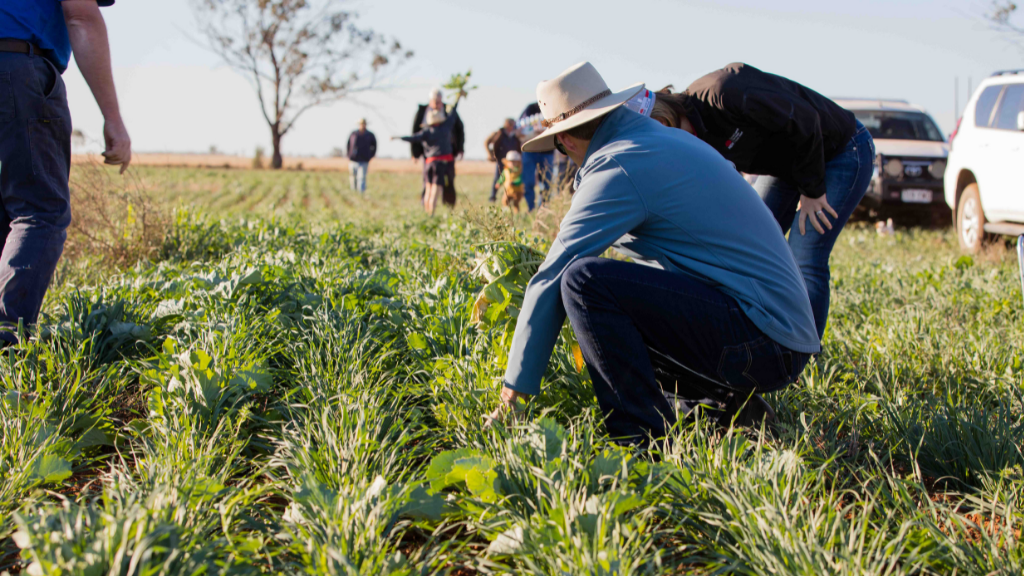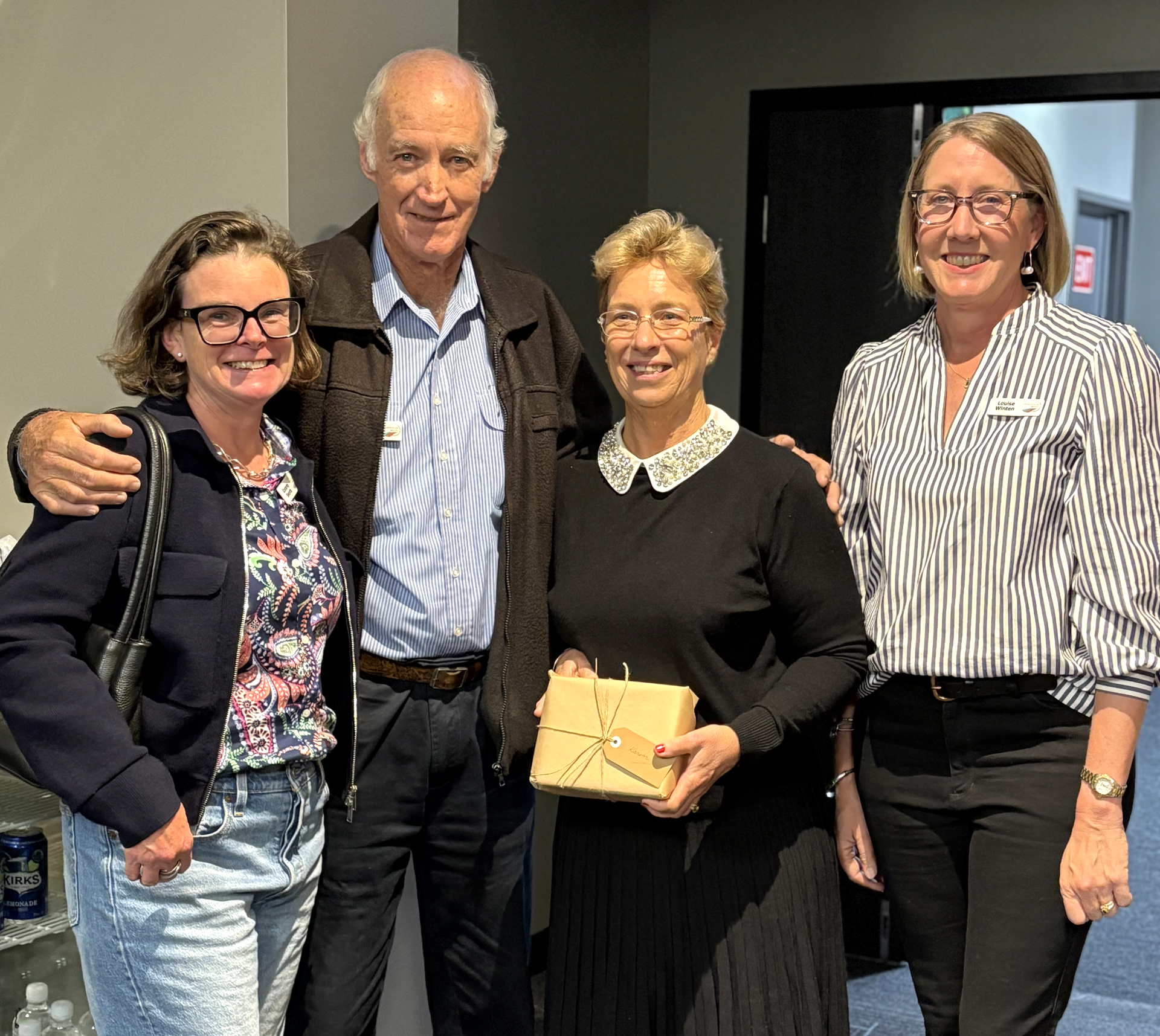Soil Health and Regenerative Agriculture
Change is underway at Kioma Station near Toobeah in South-West Queensland, to improve profitability and create a more sustainable farming system.
Local landholders around Toobeah, west of Goondiwindi, were invited to a field day in June to see first-hand how farming country is being regenerated at Kioma, a large, mixed farming and grazing operation. The day was hosted by Southern Queensland Landscapes’ Emma King, whose husband Angus is the farm manager at Kioma.
Around 30 people braved the cool and windy weather to hear more about how to manage and improve soil health and ground cover with the help of multi-species plantings and vermiculture, from fellow land holders and agricultural service providers.
The day began with a talk from veteran farmer, Ran Mitchell, who took visitors back in time, to share he and wife Jenny’s journey over 50 years to regenerate the soil on their farm near North Star in North-West NSW.
The Mitchell’s began focusing on ‘regenerative’ agricultural principles decades ago, before the term ‘regenerative agriculture’ had been coined. Over the years they’ve developed a passion for harnessing and working with the natural rhythms of their land, flora and fauna. Unlike today, Ran was breaking new ground, figuratively speaking.
Rod and Maree Farrow, (Rod works for Ran on Leyland) run Vermagra – their worming farming enterprise. The team uses very few pesticides, plants multi-species cover crops and includes regular long fallows in the farming system.
“I watched the opening up of land for farming in what was to become known as ‘The Golden Triangle’,” Ran says.
“It didn’t take long before I could see and sense that we were working against our soil and nature in severe ways. The sound of shear bolts breaking on the neighbour’s blade plough as it hit stumps kept me awake at night and led me to the realisation that this was not the way forward.”
It was 45 years ago after having some basic water infiltration tests done on a stand of native vegetation and in a field that had been farmed since the 1930s that stands out.
“I can’t remember what the different infiltration rates were, but we were so dismayed we parked the disc ploughs we had and began no-till farming in earnest,” Ran said.
“To you people here, now is the time to form a vision for the future.
“To start, make just one plan to change one thing for the better.
“It’s ultimately about helping balance what we take out of the soil and putting back in the most natural way.
“One handful of fertile soil contains more living things than people on Earth – just recently we’ve learned that the underground livestock (biology) living in a hectare of healthy soil, would weigh eight tonnes.
“Eight tonnes of things we can’t see but need to grow and preserve.”
Kioma provided the perfect backdrop to discuss soil health, now nearly 15 years into a journey in regenerative farming. Much of the journey has been guided by Ian Moss from FARM Agronomy & Resource Management (FARM), who was on hand to share his knowledge and discuss options and decisions for planting and managing forages and/or pastures from a regenerative agriculture perspective. He’s working with Angus and farming manager Ewen who oversees the regenerative farming strategies, including their on-site worm bioreactors.
Ian says the aim is to build the capacity of the soil to improve productivity and profitability by focusing on soil quality, namely through increasing soil organic matter levels.
Kioma is a mix of clay vertisols, varying from red through to lighter black country and was previously managed in what is generally described as ‘traditional’ farming methods, in a winter-crop dominant system, heavily relevant on herbicides and synthetic fertilisers.
The current regenerative system grew from an early focus on nutrition.
“In the early days I was helping nutrition, which included a focus on soil testing and fertiliser rates,” Ian said.
“An initial step in this journey was to add liquid injections at planting and seed dressings to provide micronutrients with biological seed treatments.”
The next big step was looking at soil fertility as a whole and move to more long-term thinking and planning.
“As agronomists and farmers, we are really good at looking at a paddock and working out how to make the most money from it in the next six months,” Ian said.
“What we aren’t so good at, is understanding the impact of crop sequences, fallows and covers over 10 years, these are big things that make a difference to profitability.
“To determine what was needed long term required us to look at what was holding back yield, sub-soil constraints and a method to rebuild soil health over time.”
Changes at Kioma have included an aim to keep 20 percent of the area for summer cash cropping to spread risk and give opportunity to grow cover crops in long fallows. The farm works towards a five-year rotation of three winter cash crops in a row then a long fallow summer cash crop.
“We have moved chickpeas to the last winter crop before long fallowing to sorghum because it doesn’t have value as a standing stubble cover crop – we will plant cover after chickpea harvest at the earliest opportunity.
“The rotation plan rarely happens as planned and we deliberately throw out the five-year plan every time we have a decent fall of rain, or a planting window closes.
“By doing that and having cover crops in the mix we’ve been able to help Angus utilise them for grazing, which was particularly valuable in the last drought.”
They’ve moved away from pre-plant N application and are now using a spreader to add N in the form of sulphate of ammonia if, and when needed. Plant testing is another widely used tool.
“Often it’s the nutrient excesses that we deal with first before the deficiencies,” Ian says.
“By knowing what is left in the soil, post-harvest, all the options are open to us.”
Multi-species forage crops are a key to improving soil health. The field day visitors had a close look at a field planted with oats, barley, triticale, wheat, field peas, vetch, tillage radish, forage brassica and falcon leafy turnip. The multi-species aspect is building better quality and quantity of forage and the diversity of plant roots helps build the soil through promoting biological growth and water infiltration.
The next big step will bring the worms into the mix, starting this year. A liquid extract from the vermicast will be used for seed dressing, liquid injection at planting and as foliar treatments to reduce reliance on synthetic fertilisers.
Ian says the interest in regenerative agriculture is certainly growing. So what brings landholders to explore regenerative ag?
“There are two main reasons landholders come to us,” he said.
“Either they’ve seen and heard about regen ag and what we do, or, more and more I’m getting phone calls from people saying ‘I don’t know what I need to change but know I need to change something’ mainly because they’re experiencing increases in farming costs but not seeing this translated into increasing yields.
“My job is to make ‘sustainable farming profitable’.
“It is really about the farming system and starting to understand and appreciate the actions we take and how they affect everything else, in terms of the long-term health of our soil – which is the greatest asset we have on our farms – if it is healthy.”
The field day wound up with a presentation from Christian Capp from Data Farming who gave a practical and useful outline of the value of data and mapping to manage soil and farming systems.
To learn more about events like this, check out: https://www.sqlandscapes.org.au/events
Become a member of Southern Queensland Landscapes: https://www.sqlandscapes.org.au/become-a-member
Article authored by: Melanie Jenson
This event was supported by Southern Queensland Landscapes and Millmerran Landcare through funding from the Queensland Governments Natural Resource Investment Program.
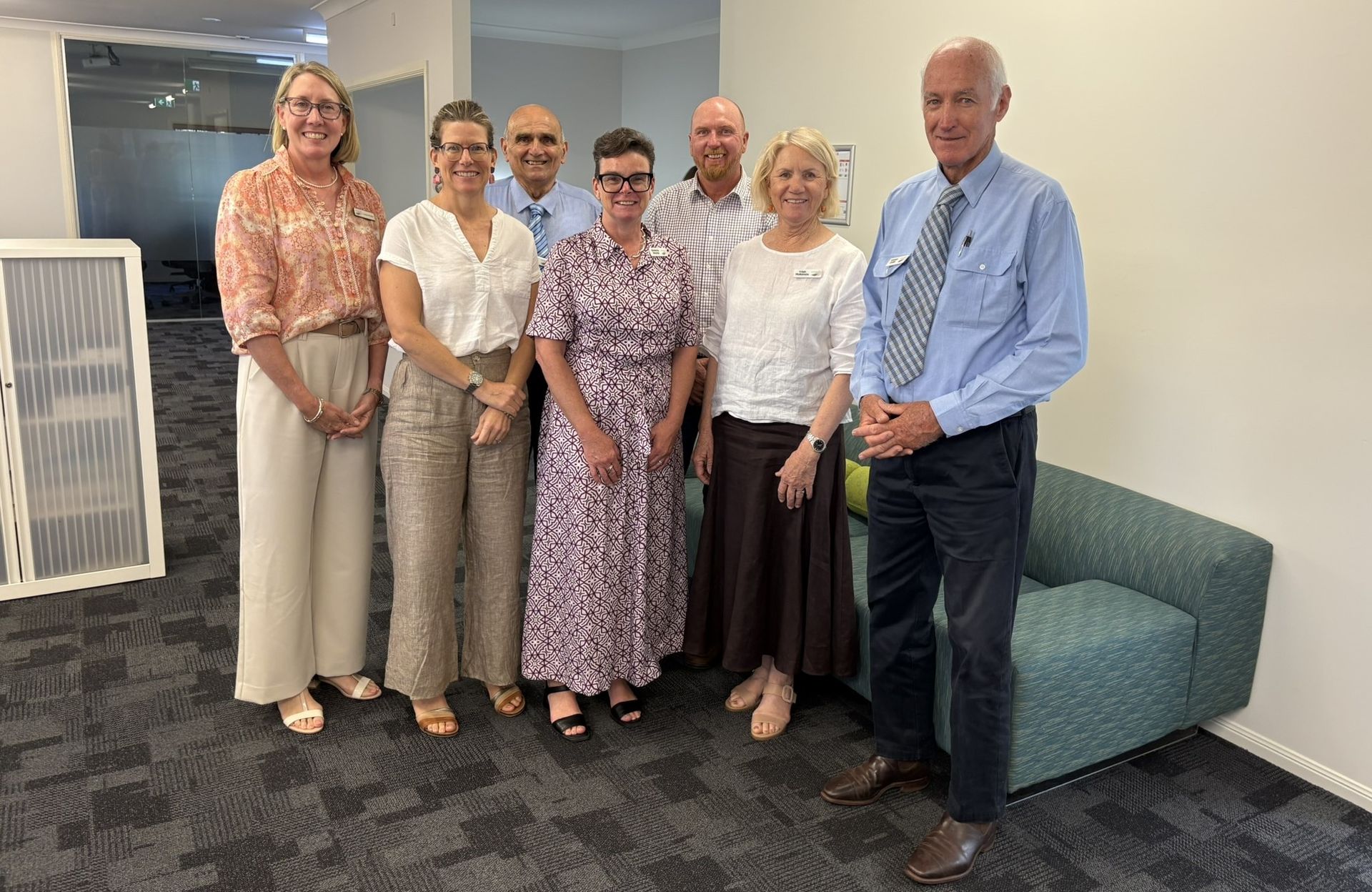
Southern Queensland Landscapes is pleased to announce key leadership changes following its 2025 Annual General Meeting, including the appointment of Anthony Glasson as the organisation’s newest Board Director. Anthony, who operates Picarilli Merinos near Thargomindah, brings broad experience in primary production, regional leadership and natural resource management. His long-standing involvement in rural industries and commitment to sustainable land stewardship will be pivotal in supporting Southern Qld Landscapes delivery under its NRM Regional Plan, Flourishing Landscapes, Healthy Communities . Southern Qld Landscapes also confirms the reappointment of Directors, Louise Winton from Morven and Pippa Jones from Goondiwindi. Both Directors bring substantial governance experience and strong regional perspectives, and their renewed terms will continue to support their commitment to community-led outcomes. Additionally, Southern Qld Landscapes acknowledges the contribution of retiring Director Hollie Grimwade, whose service has strengthened their strategic direction and regional engagement. Board Chair, Kimberley Swords said “these appointments reflect the stability and capability of Southern Qld Landscapes governance and the organisation’s strong focus on delivering real outcomes for our communities.” In welcoming and recognising the Directors, Ms Swords said: “I am very pleased to welcome Anthony Glasson as a new Director of Southern Qld Landscapes. Anthony brings a wealth of practical knowledge from his leadership of Picarilli Merinos and a deep commitment to our region. His understanding of land stewardship and his passion for community-led change will be invaluable. I also congratulate and warmly acknowledge the reappointment of Directors Louise Winton and Pippa Jones. I also want to sincerely thank our retiring Director, Hollie Grimwade. Her commitment, professionalism and regional understanding have been significant assets throughout her tenure.” “I would also like to acknowledge our dedicated staff, who continue to deliver meaningful outcomes for landholders, partners and communities. This year, we delivered more than $9 million worth of project activity across the region, with on-ground and in community work to support sustainable agriculture and build community resilience,” said Ms Swords. Members also voted at the AGM to adopt a new modernised, constitution in line with contemporary not for profit governance expectations. Southern Qld Landscapes looks forward to working under its renewed Board leadership to advance regional priorities, continue strong partnerships, and deliver tangible benefits across the Southern Queensland region.

At Southern Queensland Landscapes, you’ll join a team that is dedicated to working with landholders, community groups, industry, and government to deliver practical, science-based solutions that support farming, biodiversity, and the health of our landscapes. Working with us is more than just a job—it’s an opportunity to make a real difference. You’ll contribute to projects that care for the environment, strengthen regional communities, and create a lasting legacy for future generations. If you’re passionate about healthy landscapes, thriving communities, and meaningful work, you’ll feel right at home with us. As a leader in the Program Delivery team, you will play a key role in developing and implementing communication, extension, and adoption strategies for Southern Queensland Landscapes’ environmental and sustainable agriculture projects. You’ll also be responsible for maintaining Southern Queensland Landscape’s brand integrity and consistency across all corporate communications. Reporting to a Programs Manager, you’ll work with minimal supervision to deliver on the responsibilities outlined below. What You Will Do In this role, you will develop communication, extension, and adoption plans for projects and proposals, while supporting the delivery of communications and events for sustainable agriculture and natural resource management initiatives, including managing subcontractors. You will oversee corporate communications to ensure consistent brand representation, organise and facilitate workshops, field days, and other extension activities, and collaborate with stakeholders such as community groups, farmers, researchers, and industry partners to strengthen partnerships. Additional responsibilities include preparing reports on communication and extension outcomes with budget tracking, managing and providing support for Southern Queensland Landscape’s CRM system, maintaining communication resources including the media library, and enhancing the customer journey for land manager partnerships and membership. About You We’re seeking a motivated communicator with a passion for agriculture and the environment. To thrive in this role, you’ll bring: Relevant tertiary qualifications in Communications, Agricultural Science, Agribusiness, or Environmental Science. Proven ability to develop and deliver communication and extension plans that make an impact. Outstanding written and verbal communication skills. Strong project management and organisational skills to keep everything on track. Experience in social media, marketing, and content creation, including CRMs and visual assets. Event planning and coordination expertise for workshops, field days, and community activities. A collaborative mindset with the ability to work independently and exercise initiative. Confidence in building relationships with diverse stakeholders and resolving issues positively. Ability to manage subcontractor partnerships effectively. High-level computer literacy, data management, and reporting skills. Analytical and problem-solving abilities to tackle challenges creatively. Knowledge of Australian farming systems, technologies, and challenges. A current driver’s licence and willingness to travel across the region. Why Join Us? At Southern Queensland Landscapes, you will work in a supportive, collaborative environment where your contributions truly matter. You’ll enjoy variety in your work, opportunities to learn and grow, and the satisfaction of being part of a team that’s making a tangible difference for our environment and regional communities. If you’re looking for a role that combines purpose, teamwork and professional growth — apply now and help us create a thriving, sustainable future for southern Queensland.

At Southern Queensland Landscapes, you will be part of a team that works with landholders, community groups, industry and government to deliver real, science-based solutions to support farming, biodiversity, and the health of our landscapes. Working with us means more than just a job; it’s a chance to make a positive difference. You’ll be contributing to practical projects that care for our environment, strengthen regional communities and leave a legacy for future generations. If you’re passionate about healthy landscapes, thriving regional communities and meaningful work, you will find your place with us. We are looking for an organised and proactive Administration Officer to join our friendly and committed team. In this diverse role, you’ll provide essential financial, human resourcing and administrative support across the organisation, ensuring smooth day-to-day operations and exceptional service to internal and external stakeholders. What You Will Do You’ll be the go-to person who keeps everything running seamlessly, whether it’s greeting visitors, managing correspondence, or coordinating meetings, travel and events. You’ll provide high-level executive support to the CEO and Executive Leadership Team, assist with finance and HR processes, and help maintain the systems, facilities and resources that underpin our work. Every day will bring variety from supporting community projects and team activities to finding smarter ways to improve communication and workflow. You’ll play a vital role in helping us deliver meaningful impact across southern Queensland. About You You’re a natural organiser with strong attention to detail and a positive, professional manner. You enjoy working with people and take pride in delivering high-quality support. You bring: A Certificate II (or higher) in Business or Administration, or equivalent experience Demonstrated experience across a broad range of administrative functions including reception and executive support, IT support, facilities and equipment maintenance, and office operations Excellent communication and interpersonal skills, with the ability to engage confidently with colleagues, partners and community members Strong organisational and time management skills, balancing competing priorities with care and accuracy Initiative, adaptability and a proactive approach to problem-solving A genuine commitment to teamwork, learning and continuous improvement Why Join Us? At Southern Queensland Landscapes, you will work in a supportive, collaborative environment where your contributions truly matter. You’ll enjoy variety in your work, opportunities to learn and grow, and the satisfaction of being part of a team that’s making a tangible difference for our environment and regional communities. If you’re looking for a role that combines purpose, teamwork and professional growth — apply now and help us create a thriving, sustainable future for southern Queensland.
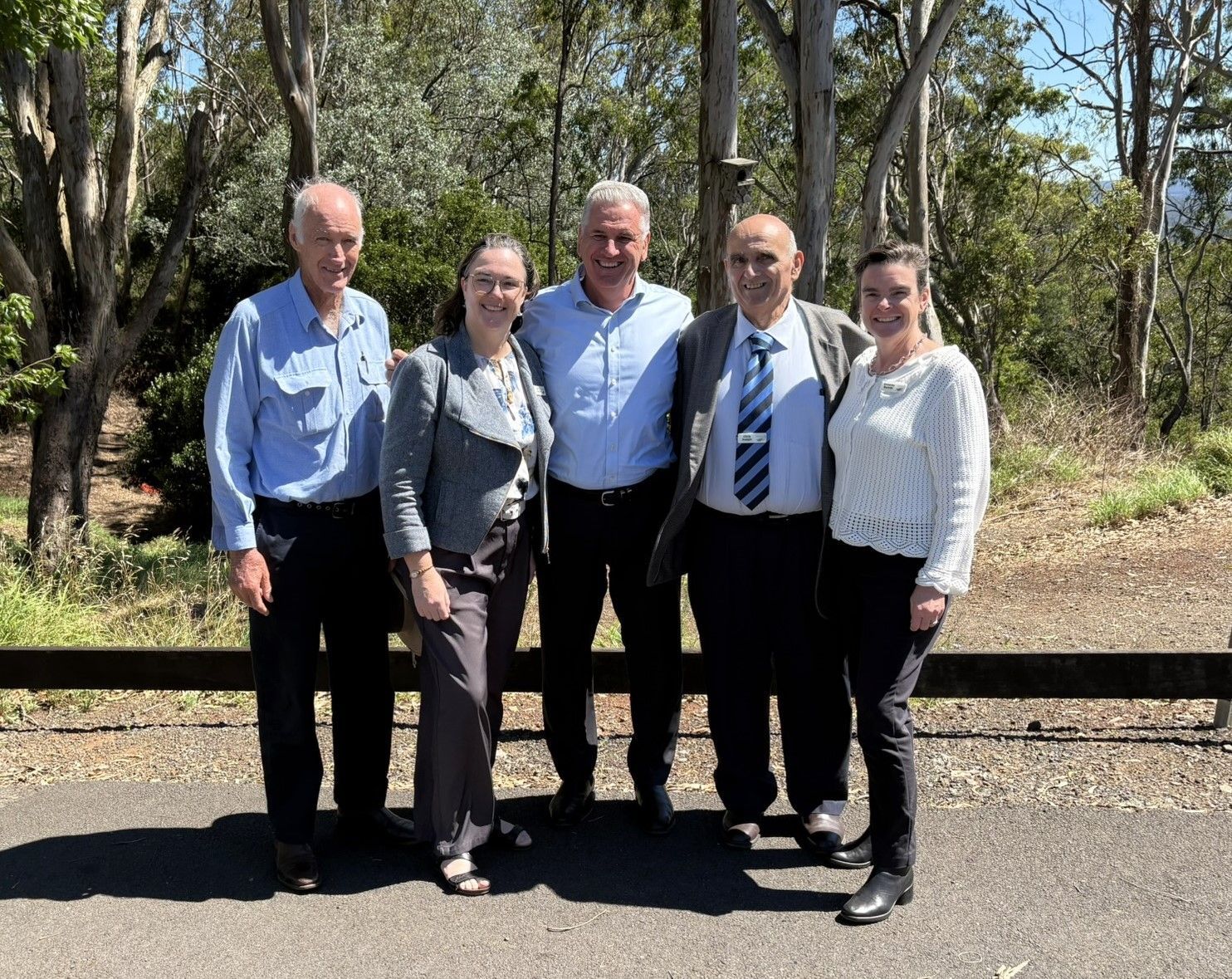
Southern Queensland is set to benefit from a major investment in Queensland’s natural assets, with more than $9 million allocated through the Queensland Government’s Natural Resource Management Expansion Program and delivered by Southern Queensland Landscapes. Southern Queensland Landscapes will receive $6.6 million to work with landholders to improve more than 124,000 hectares of land and vegetation adjacent to key waterways by installing fencing and watering points to better manage grazing. A further $2.5 million is allocated to the improvement of priority koala habitats and support animal movement and survival across Southern Queensland. This targeted action to remove key threats including wild dogs and invasive cactus species. Southern Queensland Landscapes CEO, Gillian Meppem said “the investment highlights the vital link between healthy landscapes, productive agriculture, resilient koala populations and thriving waterways.” “We are looking forward to delivering two key projects in partnership with landholders, through the Natural Resource Management Expansion Program. These projects are focused on protecting our waterways through improved grazing management and supporting thriving koala populations across Southern Queensland.” “Better grazing management, strategic fencing, and improved stock water infrastructure will enhance ground cover and protect waterways, ensuring our landscapes are more capable of resisting and recovering from natural disasters and the impacts of a changing climate.” “We are improving koala habitat by tackling key threats such as wild dogs and invasive cactus and supporting greater genetic diversity to ensure thriving koala populations across southern Queensland,” she said. Minister for Natural Resources and Mines, Manufacturing and Regional and Rural Development, The Honourable Dale Last, said “the funding demonstrates the Queensland Government’s strong commitment to supporting regional communities and natural resource management.” “When we came into government, we promised we would double funding for NRM organisations, and we would ensure our regional workforce would benefit, and we are delivering on that promise. “These NRM organisations are leading the way in safeguarding our natural resources, and that’s why we’re proud to support them and invest in Queensland’s future.” The NRMEP is a partnership between the Queensland Government and NRM Regions Queensland to deliver $117.84 million in on-ground land, water and biodiversity programs over the next three years.
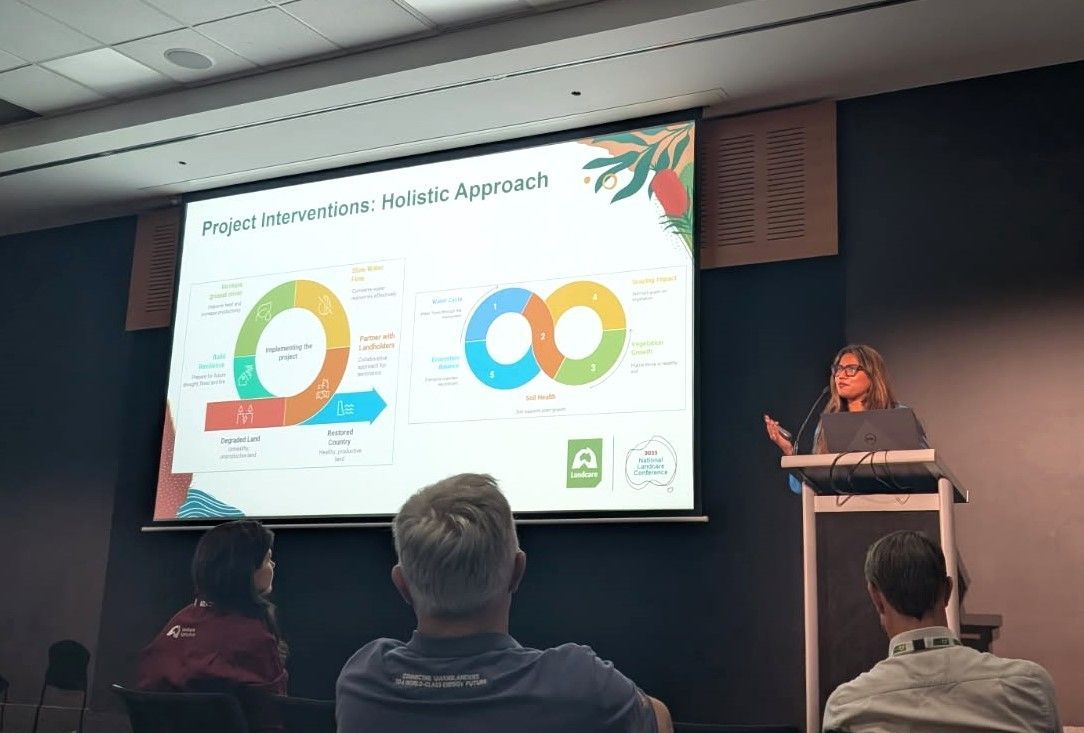
We are seeing fantastic momentum across the region, with strong interest from landholders in improving land condition. Even better, clusters of neighbouring properties are getting involved, a promising sign for achieving landscape-scale change that supports water infiltration, soil health, and resilient groundcover. To help visualise this, Projects Lead Payel Sinha, developed a set of clever graphics that capture the essence of the NRRP program. The circular diagram below shows how water, soil, vegetation, grazing, and ecosystem balance are interconnected, all working together to support healthier landscapes.
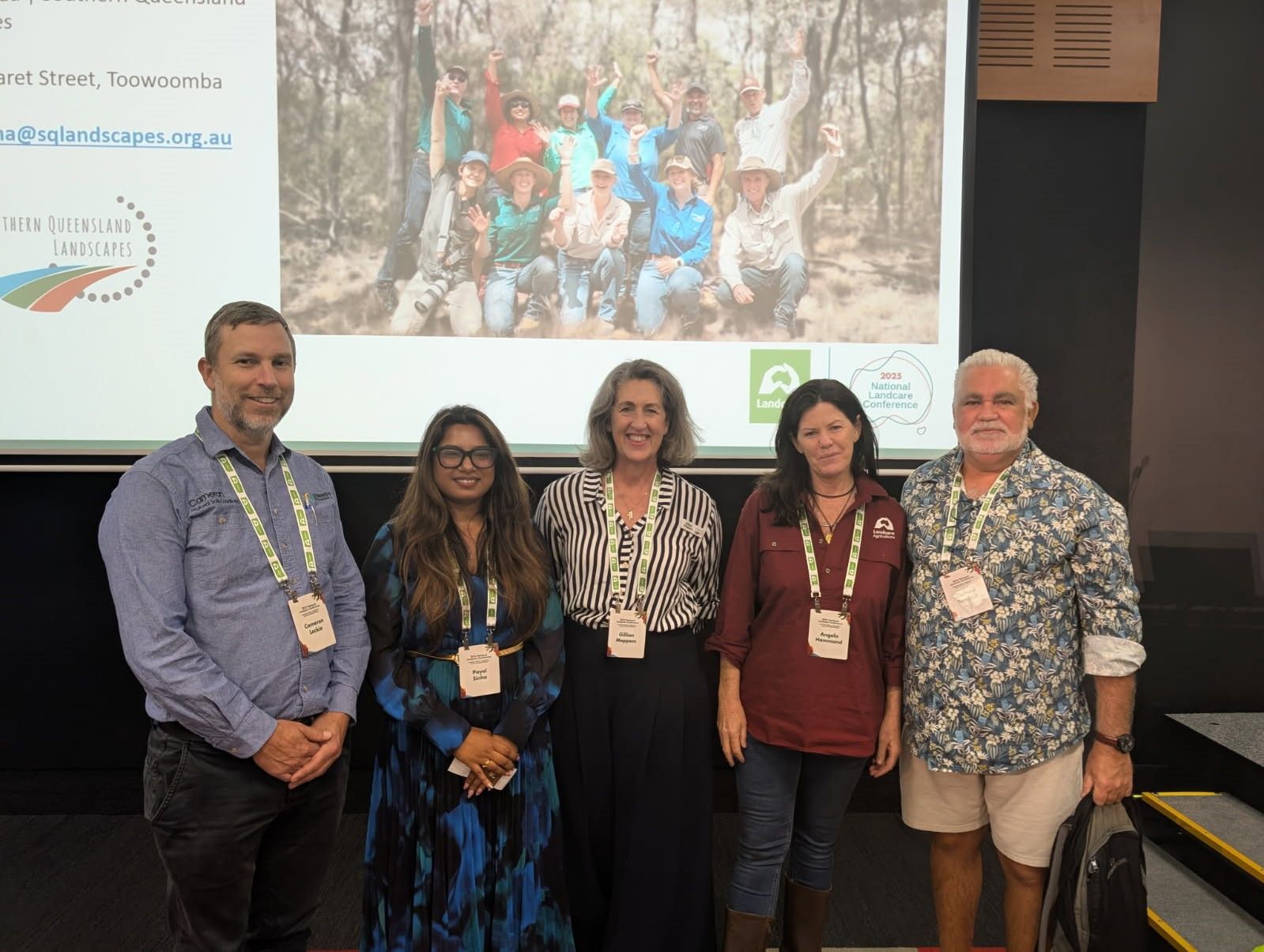
We were honoured to have CEO Gillian Meppem, Richard Turnbull, Dr Payel Sinha and Uncle Kevin, a Margany Elder from near Quilpie, come together on the Gold Coast for this year’s Landcare Conference, representing our vision, work and cultural partnerships across the region. Dr Payel Sinha delivered a presentation on the Natural Resource Recovery Program: A Holistic Approach to Restoring Landscapes , showcasing how integrative, place-based strategies can unite ecological health, cultural values and community resilience.
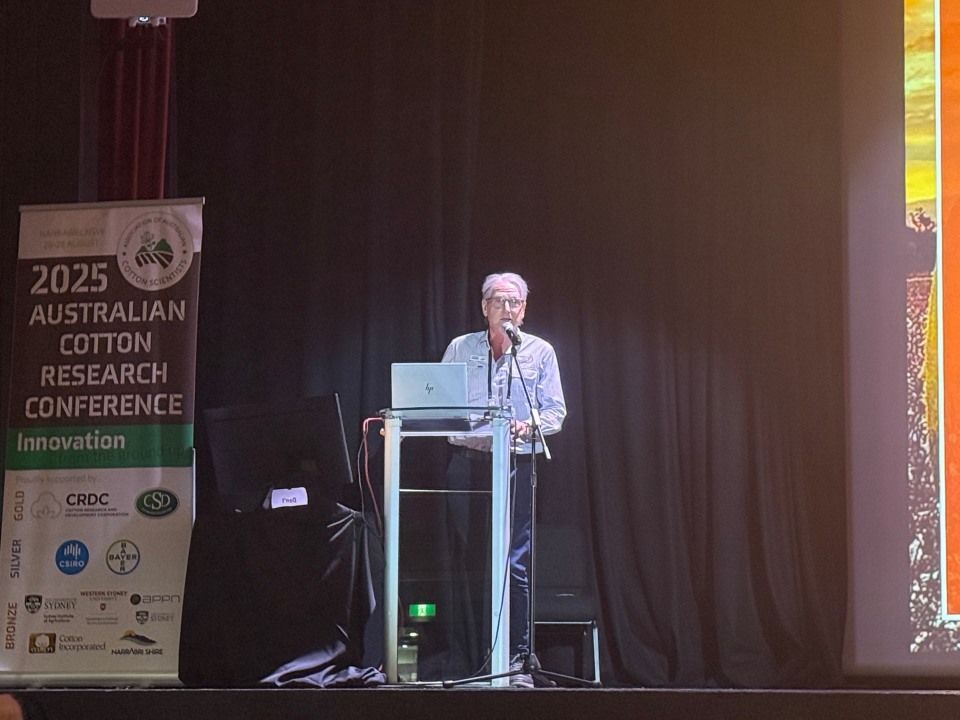
The rapidly evolving global market for agricultural commodities, including cotton, was front and centre at the recent Australian Cotton Research Conference held in Narrabri, NSW. A key theme throughout the event was the increasing pressure climate change places on cotton production and how the industry is adapting through innovation and research. Andrew Davidson of Southern Queensland Landscapes introduced an innovative national project funded by the Cotton Research and Development Corporation (CRDC). The project focuses on mapping woody vegetation across cotton farms in Australia, a crucial step toward better understanding on-farm biodiversity and supporting sustainability goals. The project uses a cutting-edge methodology developed by Southern Queensland Landscapes, drawing on a national dataset curated by the Terrestrial Ecosystem Research Network (TERN). What makes this approach unique is its ability to consistently measure vegetation across state and territory lines, overcoming long-standing challenges caused by fragmented and inconsistent regional datasets. The initiative is a true collaboration between the cotton industry, Natural Resource Management (NRM) groups, and NRM Regions Australia. Together, they aim to build a national picture of woody vegetation cover, including how much of it connects to larger, regional biodiversity corridors. Why It Matters... This vegetation data will provide a scientifically robust and cost-effective indicator of potential biodiversity on cotton farms. In practical terms, it can help: • Support cotton growers in meeting environmental standards for market access • Inform risk management strategies and conversations with financiers • Align with international frameworks such as: - The Science-Based Targets for Nature - The Post-2020 Biodiversity Framework - The Taskforce on Nature-related Financial Disclosures (TNFD) As the cotton industry looks to remain competitive and resilient in a changing climate, initiatives like this are critical. They help position Australian cotton as a globally trusted, environmentally responsible product.
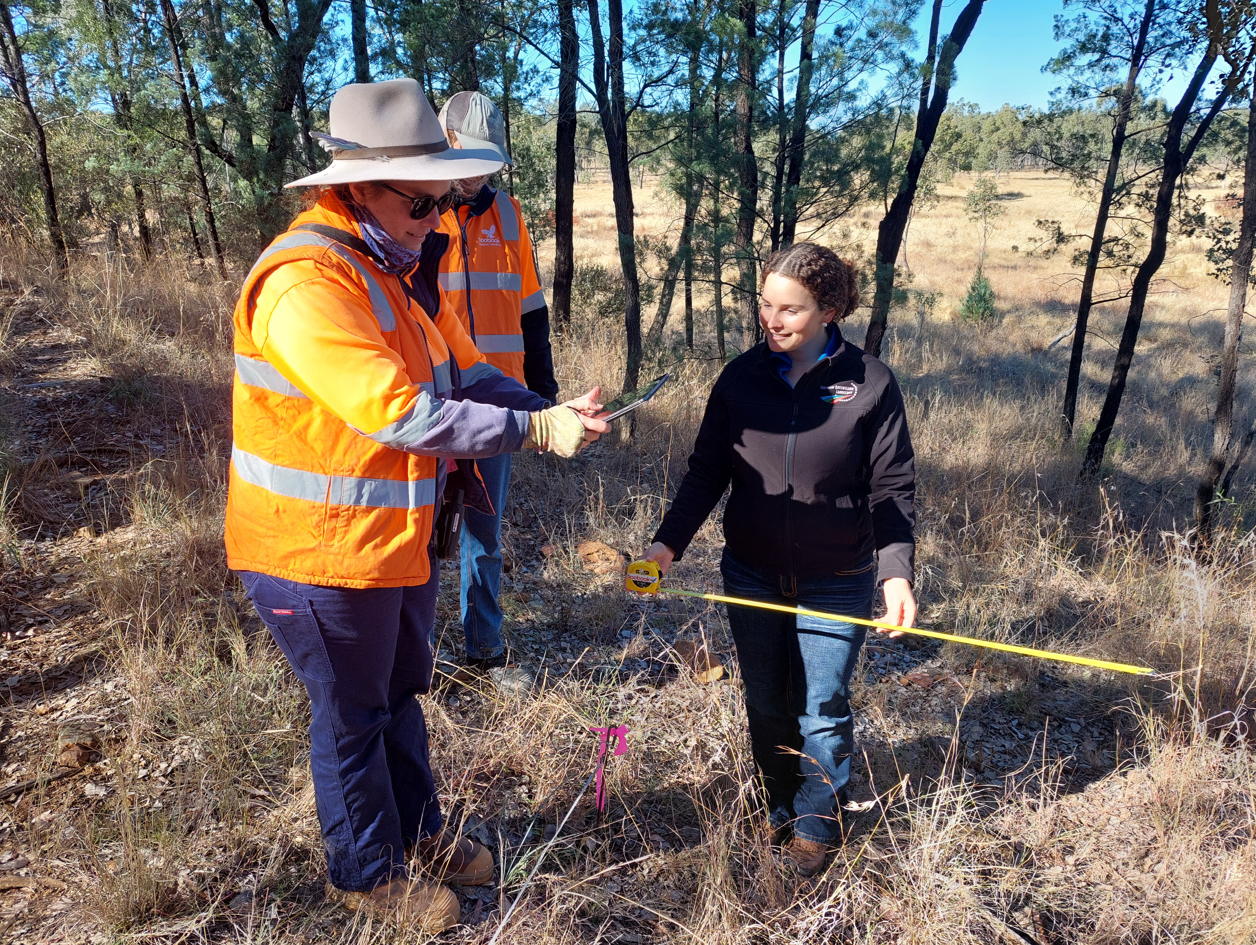
Project Officers Katrina Higgins and Erin Landsberg recently joined Rose and Weston from Boobook Ecological Consulting in Roma, to complete field monitoring in the Murweh and Maranoa districts. This monitoring measures the value and health of Coolibah, Poplar Box, and Brigalow habitat. During this time, we deployed acoustic recorders and motion-sensor wildlife cameras, and took DNA samples from nearby water sources to ascertain the fauna within these threatened habitats.
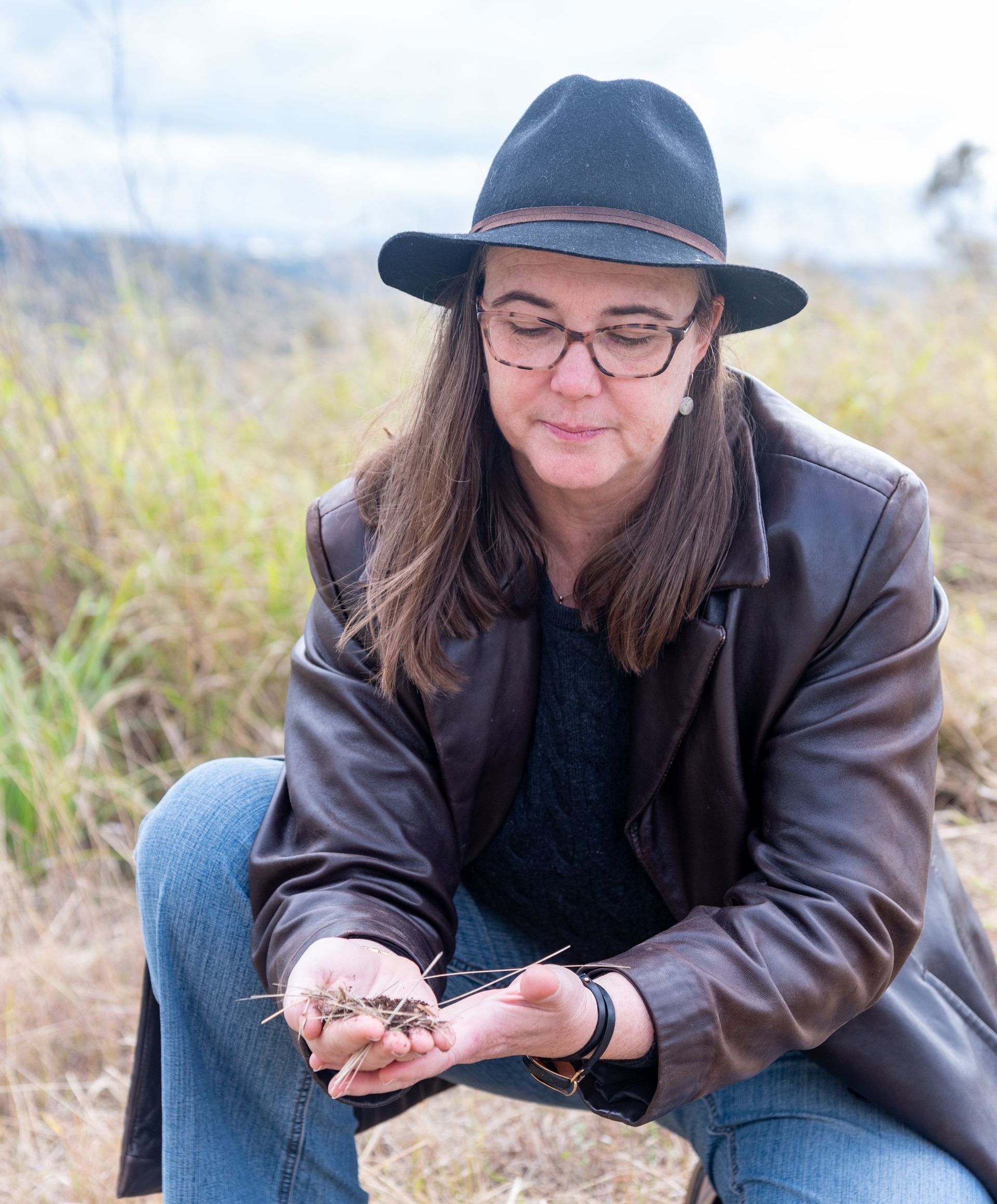
Playing a Leading Role in the National Soil Monitoring Program Queensland’s regional Natural Resource Management (NRM) organisations are playing a leading role in the National Soil Monitoring Program (NSMP), one of Australia’s most ambitious efforts to assess and improve soil health. Funded by the Australian Government through the Natural Heritage Trust and led by CSIRO, the NSMP will involve sampling at approximately 3,000 sites nationwide over three years, more than 850 of those in Queensland, with a focus on key agricultural zones. Queensland’s NRM groups have formed northern and southern clusters to deliver the program, contributing valuable expertise from over 25 years of on-ground experience. Southern Queensland Landscapes will lead delivery for the QLD South cluster of regions. The data collected will provide a nationally consistent picture of soil condition and health, enabling better decision-making for farmers, land managers, and policymakers to support sustainable, climate-smart agriculture. Jayne Thorpe, Business Development Manager at Southern Queensland Landscapes said, “In total, the QLD South cluster will collect 565 soil samples over the course of the project. That will work out as 11.3 tonnes of soil sent for analysis!”
